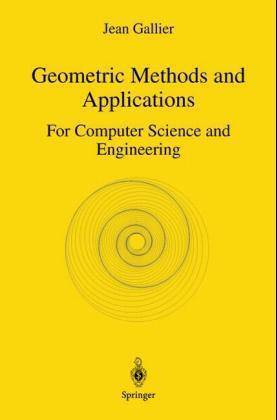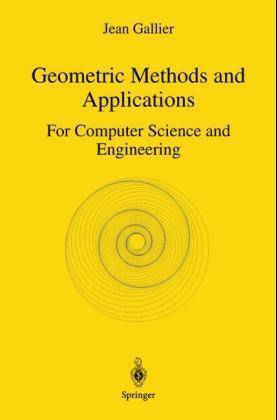
- Retrait gratuit dans votre magasin Club
- 7.000.000 titres dans notre catalogue
- Payer en toute sécurité
- Toujours un magasin près de chez vous
- Retrait gratuit dans votre magasin Club
- 7.000.0000 titres dans notre catalogue
- Payer en toute sécurité
- Toujours un magasin près de chez vous
Description
1 Introduction.- 1.1 Geometries: Their Origin, Their Uses.- 1.2 Prerequisit es and Notation.- 2 Basics of Affine Geometry.- 2.1 Affine Spaces.- 2.2 Examples of Affine Spaces.- 2.3 Chasles's Identity.- 2.4 Affine Combinations, Barycenters.- 2.5 Affine Subspaces.- 2.6 Affine Independence and Affine Frames.- 2.7 Affine Maps.- 2.8 Affine Groups.- 2.9 Affine Geometry: A Glimpse.- 2.10 Affine Hyperplanes.- 2.11 Intersection of Affine Spaces.- 2.12 Problems.- 3 Properties of Convex Sets: A Glimpse.- 3.1 Convex Sets.- 3.2 Carathéodory's Theorem.- 3.3 Radon's and Helly's Theorems.- 3.4 Problems.- 4 Embedding an Affine Space in a Vector Space.- 4.1 The "Hat Construction," or Homogenizing.- 4.2 Affine Frames of E and Bases of Ê.- 4.3 Another Construction of Ê.- 4.4 Extending Affine Maps to Linear Maps.- 4.5 Problems.- 5 Basics of Projective Geometry.- 5.1 Why Projective Spaces?.- 5.2 Projective Spaces.- 5.3 Projective Subspaces.- 5.4 Projective Frames.- 5.5 Projective Maps.- 5.6 Projective Completion of an Affine Space, Affine Patches.- 5.7 Making Good Use of Hyperplanes at Infinity.- 5.8 The Cross-Ratio.- 5.9 Duality in Projective Geometry.- 5.10 Cross-Ratios of Hyperplanes.- 5.11 Complexification of a Real Projective Space.- 5.12 Similarity Structures on a Projective Space.- 5.13 Some Applications of Projective Geometry.- 5.14 Problems.- 6 Basics of Euclidean Geometry.- 6.1 Inner Products, Euclidean Spaces.- 6.2 Orthogonality, Duality, Adjoint of a Linear Map.- 6.3 Linear Isometries (Orthogonal Transformations).- 6.4 The Orthogonal Group, Orthogonal Matrices.- 6.5 QR-Decomposition for Invertible Matrices.- 6.6 Some Applications of Euclidean Geometry.- 6.7 Problems.- 7 The Cartan-Dieudonné Theorem.- 7.1 Orthogonal Reflections.- 7.2 The Cartan-Dieudonné Theorem for Linear Isometries.- 7.3 QR-Decomposition Using Householder Matrices.- 7.4 Affine Isometries (Rigid Motions).- 7.5 Fixed Points of Affine Maps.- 7.6 Affine Isometries and Fixed Points.- 7.7 The Cartan-Dieudonné Theorem for Affine Isometries.- 7.8 Orientations of a Euclidean Space, Angles.- 7.9 Volume Forms, Cross Products.- 7.10 Problems.- 8 The Quaternions and the Spaces S3, SU(2), SO(3), and ?P3.- 8.1 The Algebra ? of Quaternions.- 8.2 Quaternions and Rotations in SO(3).- 8.3 Quaternions and Rotations in SO(4).- 8.4 Applications of Euclidean Geometry to Motion Interpolation.- 8.5 Problems.- 9 Dirichlet-Voronoi Diagrams and Delaunay Triangulations.- 9.1 Dirichlet-Voronoi Diagrams.- 9.2 Simplicial Complexes and Triangulations.- 9.3 Delaunay Triangulations.- 9.4 Delaunay Triangulations and Convex Hulls.- 9.5 Applications of Voronoi Diagrams and Delaunay Triangulations.- 9.6 Problems.- 10 Basics of Hermitian Geometry.- 10.1 Sesquilinear and Hermitian Forms, Pre-Hilbert Spaces and Hermitian Spaces.- 10.2 Orthogonality, Duality, Adjoint of a Linear Map.- 10.3 Linear Isometries (Also Called Unitary Transformations).- 10.4 The Unitary Group, Unitary Matrices.- 10.5 Problems.- 11 Spectral Theorems in Euclidean and Hermitian Spaces.- 11.1 Introduction: What's with Lie Groups and Lie Algebras?.- 11.2 Normal Linear Maps.- 11.3 Self-Adjoint, Skew Self-Adjoint, and Orthogonal Linear Maps.- 11.4 Normal, Symmetric, Skew Symmetric, Orthogonal, Hermitian, Skew Hermitian, and Unitary Matrices.- 11.5 Problems.- 12 Singular Value Decomposition (SVD) and Polar Form.- 12.1 Polar Form.- 12.2 Singular Value Decomposition (SVD).- 12.3 Problems.- 13 Applications of Euclidean Geometry to Various Optimization Problems.- 13.1 Applications of the SVD and QR-Decomposition to Least Squares Problems.- 13.2 Minimization of Quadratic Functions Using Lagrange Multipliers.- 13.3 Problems.- 14 Basics of Classical Lie Groups: The Exponential Map, Lie Groups, and Lie Algebras.- 14.1 The Exponential Map.- 14.2 The Lie Groups GL(n, ?), SL(n, ?), O(n), SO(n), the Lie Algebras gl(n, ?), sl(n, ?), o(n), so(n), and the Exponential Map.- 14.3 Symmetric Matrices, Symmetric Positive Definite Matrices, and the Expo
Spécifications
Parties prenantes
- Auteur(s) :
- Editeur:
Contenu
- Nombre de pages :
- 592
- Langue:
- Anglais
- Collection :
- Tome:
- n° 38
Caractéristiques
- EAN:
- 9780387950440
- Date de parution :
- 03-11-00
- Format:
- Livre relié
- Format numérique:
- Genaaid
- Dimensions :
- 164 mm x 241 mm
- Poids :
- 988 g

Les avis
Nous publions uniquement les avis qui respectent les conditions requises. Consultez nos conditions pour les avis.






